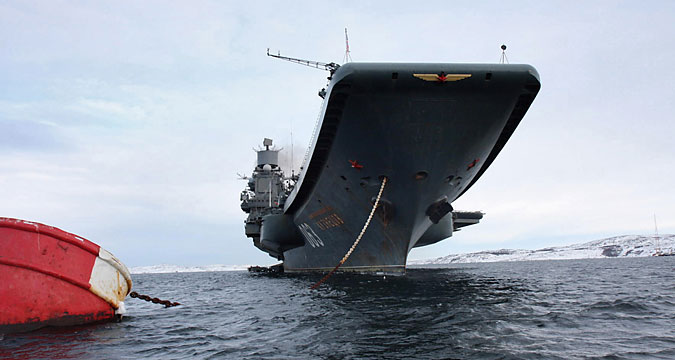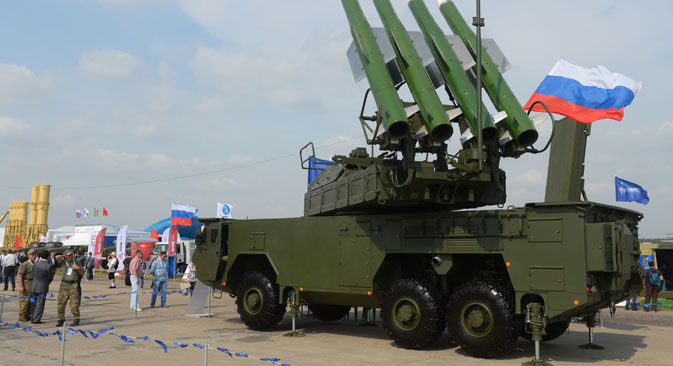9 intriguing facts about the Admiral Kuznetsov aircraft carrier

Russia's Northern Fleet aircraft-carrying heavy cruiser Admiral Kuznetsov docked at Severomorsk after a mission in the Atlantic and Mediterranean. Photo courtesy of Information and Public Relations Service of the Russian Navy.
RIA Novosti1. Unique in its class
The Admiral Kuznetsov is an aircraft-carrying cruiser – in other words, an aircraft carrier with powerful missiles. Russia is the only country in the world with such a heavily armed aircraft carrier: the aircraft carriers of other countries are essentially just floating airbases.
2. The biggest
The Admiral Kuznetsov is the biggest ship ever built in the USSR or Russia, with a displacement of nearly 62,000 tons.
3. A ship with many names
The Admiral Kuznetsov holds the record for the most name changes of any ship in Russian naval history. Initially launched as the Riga, it was renamed first as the Leonid Brezhnev, then as the Tbilisi, before finally being named for the Soviet Naval Admiral Nikolai Kuznetsov.
Source: YouTube/CtrlAltDel
4. Ski jump, not a catapult
The Admiral Kuznetsov could have had a catapult launch, but for economic reasons military authorities opted for a flight deck with a ski-jump springboard for conventional takeoffs and landings of naval aircraft.
5. Aircraft wing provides onshore training
Back in Soviet times, a special onshore training center imitating an aircraft carrier's springboard was built in Crimea for training military pilots of carrier-based aircraft. For a long time, this center belonged to Ukraine, but following the controversial events surrounding Crimea in 2014, Russia has once again taken control of the center.
6. Standing up for itself
The Admiral Kuznetsov is very well armed. It needs escort ships, too, but not as many as its American counterparts. It can defend itself if necessary: its 12 Granit anti-ship cruise missiles, six AK-630 automatic weapon systems, two Udav rocket launchers with 60 depth charges, a Kinzhal surface-to-air missile system and a Kortik gun-missile system, prevent the enemy from getting too close, whether from the air or from underwater.
7. Aircraft carrier escapes
Following the collapse of the USSR, the Admiral Kuznetsov could have been inherited by Ukraine, which claimed ownership of it. In 1991, the ship, then assigned to the Northern Fleet, underwent tests with the Black Sea Fleet in Feodosia, leaving it in Ukrainian territory. However, the first deputy commander of the Northern Fleet flew to Ukraine at once and stepped in. The vice admiral gave the order to raise the anchor immediately and head for Severodvinsk. With its navigation lights off, the ship left its harbor and spent more than three weeks sailing to its permanent base without any aircraft and without two thirds of its crew, who were off-duty at the time. Having saved the aircraft carrier, the vice admiral rightly judged that the sailors would “catch us by train,” and that the aircraft remaining at the onshore airbase would “get there by themselves.”
8. A miraculous survivor
Had the Admiral Kuznetsov stayed in Ukraine, it could have suffered the unenviable fate of its fellow ships from Project 1143. The Kiev cruiser now entertains tourists in China as a museum and hotel, while the Ulyanovsk ship was dismantled for parts. The Novorossiysk and Minsk vessels were sold to South Korea for scrap, but the latter ended up in China and also became a museum. Ukraine also sold the Varyag boat to China, which apparently intended to turn it into a floating casino. However, the Chinese government decided to rebuild it as the Liaoning, China's first aircraft carrier.
9. The most irreplaceable
In 2015 Russia's military command announced that it would be at least five years before any decision was made on whether to build a second aircraft carrier. However, the country's armament program for 2020 does not envisage the construction of an aircraft carrier, so the Admiral Kuznetsov will likely remain Russia's only such vessel for the foreseeable future.
Read more: 10 facts about the ‘Moskva’ cruiser>>>
All rights reserved by Rossiyskaya Gazeta.
Subscribe
to our newsletter!
Get the week's best stories straight to your inbox

